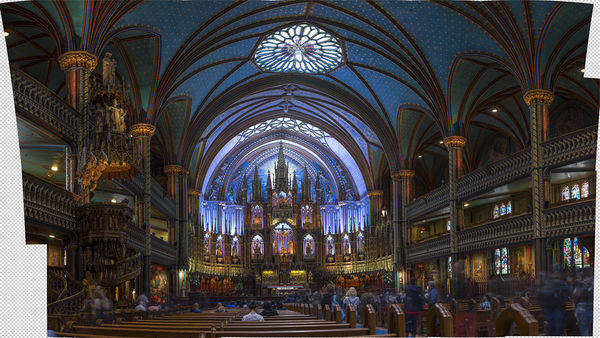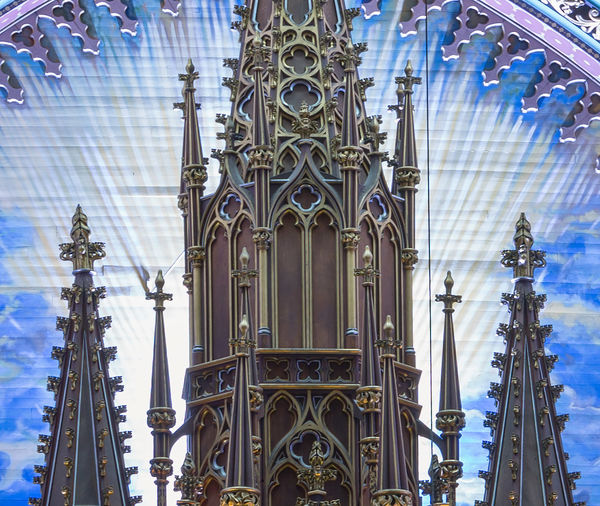Photographing cathedrals
Feb 4, 2018 12:04:27 #
Look into 14mm Rokinon. I use it a lot for architectural before i got the 24mm tse
Feb 4, 2018 12:12:45 #
you can usually find the rokinon 14 for about 299 it has some distortion, to be expected, not bad, it's rectilinear not a fisheye. For the price it's not a bad deal
Feb 4, 2018 12:21:58 #
TheDman wrote:
I was allowed a tripod in the Notre Dame Basilica in Montreal. Instead of a wide angle, I shot about 25 photos with my 70-200 and stitched them all. Don't overlook this possibility.
Very nice.
Feb 4, 2018 13:35:14 #
Mentioning the wide angle for groups of people reminded me of the guys who used to travel doing photography from their car at people's homes. Often it was a view camera with 5x7 film using a normal 210mm lens, because these could be contact-printed as enlargements (and printed on 8x10 paper with a cameo pattern surrounding the image). They had backs for the camera that would take different film sizes--and therefore different contact-print sizes, no enlarger. Anyway, your mention of the wide angle for groups was part of their plan, but instead of an assortment of lenses, they changed backs. Portraits were all taken at 8 ft, with the normal 210mm lens, which is the classical perspective. For a head shot, they used 6x9 film (or equivalent roll film back). For head-and shoulders, they used the 4x5 back. For full figure shots or small families, they used the 5x7 back. Some 5x7 backs could take two or more (even 4) identical images on one sheet of film--the contact print was then cut with scissors into wallet prints. But for bigger groups--school classes, banquets, etc.--they did have a wide angle lens, unless their camera could take an 8x10 film back with the 210mm lens.
Apparently nobody minds the loss of perspective modeling when large groups are photographed, as even with the wide angle, they had to back up some, but with today's very-wide lenses, that is not necessarily needed. If you make an arc around the camera, say 10 ft out, and line the people along the arc, they will all be proportionally sized because they will all be the same distance from the camera. If they are in a straight line, the ones toward the ends will be much farther away. Lenses are made to be flat-field, so they will all be in focus, but they cannot correct the fact that those farther away will look smaller.
Apparently nobody minds the loss of perspective modeling when large groups are photographed, as even with the wide angle, they had to back up some, but with today's very-wide lenses, that is not necessarily needed. If you make an arc around the camera, say 10 ft out, and line the people along the arc, they will all be proportionally sized because they will all be the same distance from the camera. If they are in a straight line, the ones toward the ends will be much farther away. Lenses are made to be flat-field, so they will all be in focus, but they cannot correct the fact that those farther away will look smaller.
Tom Daniels wrote:
I got down on very wide angle and wanted a more co... (show quote)
Feb 4, 2018 14:30:32 #
I have visited and photographed many cathedrals here in the UK in the last 30 or so years. Lens wise I would certainly suggest a really wide angle.
A Sigma 12 to 24mm lens would be fine.
If you are in the area on your visit you will get some fine pictures at the following Cathedrals, Wells in Somerset, Ely in Cambridge, Durham, and
certainly Lincoln in Lincolnshire. There are some wonderful shots to be had. Enjoy.
A Sigma 12 to 24mm lens would be fine.
If you are in the area on your visit you will get some fine pictures at the following Cathedrals, Wells in Somerset, Ely in Cambridge, Durham, and
certainly Lincoln in Lincolnshire. There are some wonderful shots to be had. Enjoy.
Feb 4, 2018 15:09:09 #
since many churches do not like tripods, I found that by setting the shutter speed beyond "shake" level, using the VR option and using auto ISO, I had great success. At the time i was suing an 18-200 DX nikkor lens, VR1 on a d7000.I was surprised by the quality of the pictures and relatively low noise in most of my photographs.
Feb 4, 2018 16:21:23 #
TheDman
Loc: USA
David in Dallas wrote:
TheDMan, since you were using a tripod, one assumes that all photos were taken from the same position and therefore that some would have been pointed somewhat up. I'd expect convergence of the verticals under those circumstances, so did you employ some perspective correction? (I'd have expected some tilt correction, too.)
Nevertheless, it's a nice photo.
Nevertheless, it's a nice photo.
Thanks! No real perspective correction, just some line curvature cleanup around the sides. Shooting at 70mm helps avoid some wide angle lens distortion, and the blend was pretty seamless. Here's a screenshot of the raw stitch, and a 100% crop. The finished file size was 18,000 x 11,000 - almost 200 megapixels. I didn't plan this when I walked in, but was so blown away by all the detail that I knew a single shot couldn't possibly do it justice.
Feb 4, 2018 16:36:59 #
Many of the Cathedrals and Churches have spectacular Stained Glass windows. They are very photo worthy. The trick is balancing the indoor exposure and the back lit windows. As said before, practice at home, and especially determine what the maximum ISO your camera can be set and still deliver usable photographs. These windows also complicate the overall exposure of interior photos. Don't forget the brace your camera by leaning your body against columns or, against pew tops when using longer shutter speeds.
Cathedrals throughout Europe, England and elsewhere, including here at home, are magnificent expressions of the architectural arts, paintings and art artwork displayed within. They also encompass tremendous attention to details, magnificent wood and stone carvings and sculptures. Be sure to take the time to capture these treasures while you're being overwhelmed (as is their purpose) by the scale and majesty of these buildings.
Remember the details.
Cathedrals throughout Europe, England and elsewhere, including here at home, are magnificent expressions of the architectural arts, paintings and art artwork displayed within. They also encompass tremendous attention to details, magnificent wood and stone carvings and sculptures. Be sure to take the time to capture these treasures while you're being overwhelmed (as is their purpose) by the scale and majesty of these buildings.
Remember the details.
Feb 4, 2018 16:56:23 #
TheDman wrote:
Well, the results are spectacular! I typically just do portrait-aspect shots--3 to 5--and make my panoramas from those; I also only shoot JPEG. (I don't need to have ultimate control over everything--I just want a nice picture.) My 2013 photos of that cathedral are in this Album: https://www.flickr.com/photos/8712554@N02/sets/72157635093172322/.Thanks! No real perspective correction, just some line curvature cleanup around the sides. Shooting at 70mm helps avoid some wide angle lens distortion, and the blend was pretty seamless. Here's a screenshot of the raw stitch, and a 100% crop. The finished file size was 18,000 x 11,000 - almost 200 megapixels. I didn't plan this when I walked in, but was so blown away by all the detail that I knew a single shot couldn't possibly do it justice.
Feb 4, 2018 20:02:15 #
John Battle
Loc: Tacoma, WA, USA
Thank you all so much for your interesting and very helpful responses to my question. This is the first time I've posted on this website, and the response has been nearly overwhelming! You all are so generous and helpful. Thanks again!
Feb 5, 2018 02:30:42 #
I've done quite a bit of shooting in cathedrals. I second the suggestion that you get hold of a wide angle lens. For Nikon FF I lean toward the 16-35 f4 VR, or a Rokinon 14. To avoid changing lenses all the time you might consider making two complete passes through the cathedral; one with the 24 - 70 on, and a second pass with the wide angle lens on. Also, practice shooting handheld at relatively long exposures such as 1/4 sec or even 1/3 and 1/2, particularly braced against a pillar or pew at wider focal lengths. With the D750 you can shoot comfortably for amateur use up to ISO 3200. A 1/4 sec exposure at 24 mm and ISO 3200 will get you in business in some mighty dark churches.
If you want to reply, then register here. Registration is free and your account is created instantly, so you can post right away.






